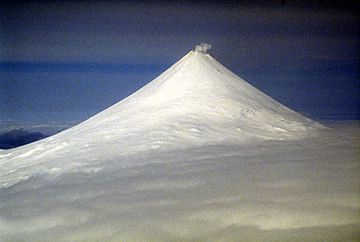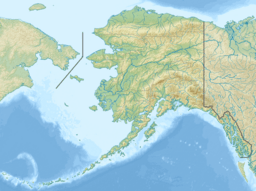Mount Shishaldin facts for kids
Quick facts for kids Mount Shishaldin |
|
|---|---|

Mount Shishaldin, May 1994
|
|
| Highest point | |
| Elevation | 9,373 ft (2,857 m) |
| Prominence | 9,373 ft (2,857 m) |
| Isolation | 877 km (545 mi) |
| Listing |
|
| Geography | |
| Parent range | Aleutian Range |
| Topo map | USGS False Pass D-6 |
| Geology | |
| Mountain type | Stratovolcano |
| Volcanic arc/belt | Aleutian Arc |
| Last eruption | January 3, 2020 |
| Climbing | |
| First ascent | May 16, 1932 by G. Peterson et al. (first recorded ascent) |
| Easiest route | East face:snow/glacier climb |
| Designated: | 1967 |
Mount Shishaldin is a very active volcano located on Unimak Island in Alaska. This island is part of the Aleutian Islands chain. Shishaldin is the tallest mountain peak in all of the Aleutian Islands.
It is known for its almost perfect cone shape. It looks like a giant, symmetrical ice cream cone covered in glaciers. The top part of the volcano, above 6,500 feet (about 1,980 meters), is almost a perfect circle. Shishaldin is one of three large stratovolcanoes on Unimak Island.
The top 6,600 feet (about 2,000 meters) of Mount Shishaldin are covered in snow and ice from glaciers. These glaciers cover an area of about 35 square miles (90 square kilometers). Around the volcano, especially to the northwest, there are 24 smaller, single-eruption volcanoes. These areas are covered by large flows of hardened lava.
The main Shishaldin cone is less than 10,000 years old. It sits on top of an older, eroded volcano. You can still see parts of this older volcano on the west and northeast sides, at elevations between 4,900 and 5,900 feet (1,490 to 1,800 meters). A steady plume of steam often rises from its small crater at the very top. This crater is about 500 feet (150 meters) wide.
In 1967, Shishaldin Volcano was named a National Natural Landmark. This means it's a special place recognized for its unique natural features.
What's in a Name?
The native Aleut people gave the volcano its original names, Sisquk or Sisagux. These names mean "mountain which points the way when I am lost." The name Shishaldin comes from the Russian version of the Aleut name.
Volcano Activity
Mount Shishaldin has been very active throughout history. Many eruptions have been recorded since the 1800s. Some reports from the 1700s might also have been about Shishaldin. This means the volcano has almost always been active.
The Alaska Volcano Observatory (AVO) has confirmed 24 eruptions at Shishaldin. This makes it one of the most active volcanoes in Alaska. It has the most total eruptions (confirmed and possible) in Alaska.
Recent eruptions happened in 1995–96 and again in 1999. Since the 1999 eruption, the volcano has shown constant seismic activity. This means it has very small earthquakes, usually below magnitude 1, happening every 1–2 minutes. During this time, it also puffs out steam every 1–2 minutes. In 2004, small amounts of ash were seen coming out with the steam.
A new period of activity began in July 2019. Scientists saw glowing light inside the summit crater. This happened during a time of increased earthquake activity. On July 23, they observed an active lava lake and small splashes of lava inside the crater.
A new lava flow started on October 13, 2019, and continued for several weeks. On November 25, part of the summit cone collapsed. This caused a fast-moving flow of hot gas and rock (called a pyroclastic flow) to rush down the northwest side. A new lava flow also started.
On December 12, a short explosion from Shishaldin sent an ash cloud up to 20,000-25,000 feet (6,100-7,600 meters). In late December, eruptions continued with more lava flows and small explosions at the top. On January 3, 2020, more seismic activity led to a large ash cloud eruption. This cloud reached as high as 27,000 feet (8,200 meters). Another big ash cloud was released on January 19, 2020. The lava flows from these eruptions carved deep channels into the snow and ice on the volcano's north slope.
The Alaska Volcano Observatory keeps a close eye on Shishaldin. They use seismometers to detect earthquakes and satellite images to watch for changes. It's hard to see the volcano up close because it's in a very remote location.
Climbing Mount Shishaldin
The first time someone officially climbed Mount Shishaldin was in 1932. A climber named G. Peterson and two friends made the ascent. Because the climb is not extremely difficult (it involves climbing snow slopes up to 40 degrees), it's possible that local Aleut people or earlier visitors climbed it before 1932.
Shishaldin is a popular spot for local climbers who enjoy skiing down. They can ski down about 6,000 feet (1,800 meters) vertically. However, because the volcano is so far away from cities, not many people from outside the area come to climb it.
Gallery
See also
 In Spanish: Monte Shishaldin para niños
In Spanish: Monte Shishaldin para niños









